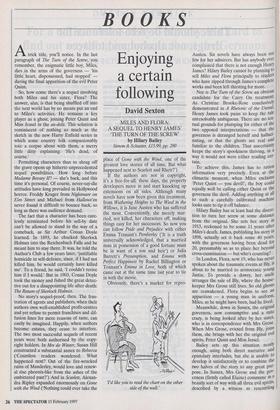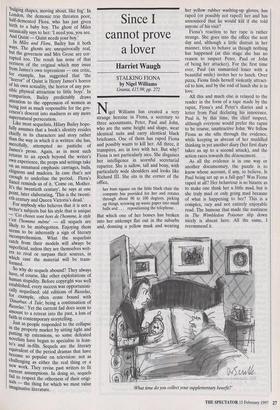BOOKS
Enjoying a certain following
David Sexton
MILES AND FLORA: A SEQUEL TO HENRY JAMES' `THE TURN OF THE SCREW' by Hilary Bailey Simon & Schuster, £15.99, pp. 280 Atrick title, you'll notice. In the last paragraph of The Turn of the Screw, you remember, the enigmatic little boy, Miles, dies in the arms of the governess — 'his little heart, dispossessed, had stopped' during the final apparition of the evil Peter Quint.
So, how come there's a sequel involving both Miles and his sister, Flora? The answer, alas, is that being shuffled off into the next world has by no means put an end to Miles's activities. He remains a key player as a ghost, joining Peter Quint and Miss Jessel in the au-dela. This solution is reminiscent of nothing so much as the sketch in the new Harry Enfield series in which some country folk companionably tote a corpse about with them, a merry little ditty explaining: 'He's dead, of course.'
Permitting characters thus to shrug off the grave opens up hitherto unprecedented sequel possibilities. How long before Madame Bovary II? — she's back, and this time it's personal. Of course, never-say-die attitudes have long prevailed in Hollywood horror. Freddy Kruger from Nightmare on Elm Street and Michael from Hallowe'en never found it difficult to bounce back, so long as there was audience demand.
The fact that a character has been care- lessly terminated before his sell-by date can't be allowed to stand in the way of a comeback, as Sir Arthur Conan Doyle learned. In 1893, he chucked Sherlock Holmes into the Reichenbach Falls and he meant him to stay there. It was, he told the Author's Club a few years later, 'justifiable homicide in self-defence, since, if I had not killed him, he would certainly have killed me'. To a friend, he said, 'I couldn't revive him if I would.' But in 1903, Conan Doyle took the money and fished the great detec- tive out for a disappointing life after death: The Return of Sherlock Holmes.
No story's sequel-proof, then. The frus- tration of agents and publishers, when their authors own well-established profit-centres and yet refuse to permit franchises and dif- fusion lines for mere reasons of taste, can easily be imagined. Happily, when authors become estates, they cease to interfere. The two most successful sequels of recent years were both authorised by the copy- right holders. In Mrs de Winter, Susan Hill constructed a substantial annex to Rebecca ('Countless readers wondered: What happened next? Out of the fire-wracked ruins of Manderley, would love and renew- al rise phoenix-like from the ashes of the embittered past?') And in Scarlett, Alexan- dra Ripley expanded enormously on Gone with the Wind (Nothing could ever take the place of Gone with the Wind, one of the greatest love stories of all time. But what happened next to Scarlett and Rhett?') If the authors are not in copyright, it's a free-for-all: these days, the property developers move in and start knocking up extensions on all sides. Although many novels have now been given this treatment, from Wuthering Heights to The Wind in the Willows, it is Jane Austen who has suffered the most. Conveniently, she merely mar- ried, not killed, her characters off, making things easy for her successors. So now you can follow Pride and Prejudice with either Emma Tennant's Pemberley (It is a truth universally acknowledged, that a married man in possession of a good fortune must be in want of a son and heir') or Julia Barrett's Presumption, and Emma with Perfect Happiness by Rachel Billington or Tennant's Emma in Love, both of which came out at the same time last year to tie in with the movie.
Obviously, there's a market for repro- `I'd like you to read the chart on the other side of the wall.' Austen. Six novels have always been too few for her admirers. But has anybody ever complained that there is not enough Henry James? Hilary Bailey cannot be planning to sell Miles and Flora principally to readers who have zipped through James's complete works and been left thirsting for more.
Nor is The Turn of the Screw an obvious candidate for the Carry On treatment. AsChristine Brooke-Rose conclusively demonstrated in A Rhetoric of the Unreal, Henry James took pains to keep the tale unresolvably ambiguous. There are no tex- tual grounds for plumping for either of the two opposed interpretations — that the governess is deranged herself and halluci- nating, or that the ghosts are real and familiar to the children. That uncertainty keeps the story's spookiness thriving, in a way it would not were either reading cer- tain.
To achieve this, James has to ration information very precisely. Even at the climactic moment, when Miles exclaims `Peter Quint — you devil!', the boy could equally well be calling either Quint or the governess the devil. Adding anything at all to such a carefully calibrated machine looks sure to tip it off balance.
Hilary Bailey has at least had the discre- tion to turn her screw at some distance from the original. She sets her story in 1913, reckoned to be some 11 years after Miles's death. James, publishing his story in 1898, actually set it back some 40 years, with the governess having been dead for 20, presumably so as to place her beyond cross-examination — but who's counting?
In London, Flora, now 19, who has never spoken about the traumatic events at Bly, rs about to be married to aristocratic young Justin. To provide a dowry, her uncle arranges the sale of Bly, where the house- keeper Mrs Grose still lives. So old ghosts are reawakened. Flora begins to see an apparition — a young man in uniform, Miles, as he might have been, had he lived. Meanwhile, down in Sussex, the original governess, now consumptive and a mite crazy, is being looked after by her sister, who is in correspondence with Mrs Grose. When Mrs Grose, evicted from Bly, joins them, she brings with her the original evil spirits, Peter Quint and Miss Jessel. Bailey sets up this situation neatly enough, using both direct narrative and epistolary interludes, but she is unable to develop it satisfactorily or to combine the two halves of the story to any great pur- pose. In Sussex, Mrs Grose and the gov- erness (firmly called Elaine) commune in a beastly sort of way with all three evil spirits, described by a witness as resembling `bulging shapes, moving about, like fog'. In London, the demonic trio threaten poor, hay-demented Flora, who has just given birth to a baby boy. The ghost of Miles satanically says to her: 'I need you, you see. And Quint — Quint needs your boy.' In Miles and Flora, Bailey has it both ways. The ghosts are unequivocally real, but the governess and Mrs Grose are cor- rupted too. The result has none of that eeriness of the original which may issue from James's own repressions — one critic, for example, has suggested that `the "horror" of Quint is Henry James's horror of his own sexuality, the horror of any pos- sible physical attraction to little boys'. In comparison, Bailey predictably draws attention to the oppression of women as being just as much responsible for the gov- erness's descent into madness as any more supernatural persecution. Like most sequelists, Hilary Bailey hope- fully assumes that a book's identity resides chiefly in its characters and story rather than the way in which it is written: she has, mercifully, attempted no pastiche of James's prose. Again, as in most such returns to an epoch beyond the writer's own experience, the props and settings take on an unnatural emphasis: carriages, balls, chignons and madeira. In case that's not enough to underline the period, Flora's fiance reminds us of it. 'Caine on, Mother. It's the twentieth century', he says at one Point, later elaborating, 'This is the twenti- eth century and Queen Victoria's dead.' For anybody who believes that it is not a writer's subjects but his style that is unique `Ces choses sont hors de l'homme, le style c'est l'homme mettle' — all sequels are likely to be misbegotten. Enjoying them seems to be inherently a sign of literary Incomprehension. What the sequelists catch from their models will always be superficial, unless they are themselves writ- ers to rival or surpass their sources, in which case the material will be trans- formed.
So why do sequels abound? They always have, of course, like other exploitations of human stupidity. Before copyright was well established every success was opportunisti- cally sequelised: old editions of Rasselas, for example, often come bound with Dinarbas: A Tale; being a continuation of Rasselas.' Yet the current fad does seem to amount to a retreat into the past, a loss of faith in contemporary storytelling. Just as people responded to the collapse in the property market by sitting tight and putting up extensions, so some defeated novelists have begun to specialise in lean- t° s and in-fills. Sequels are the literary become of the period, dramas that have income so popular on television: not as challenging as either the real thing or a new work. They revise past writers to fit current assumptions. In doing so, sequels fail to respect the otherness of their origi- nals — the thing for which we most value Ullagmative literature.



























































 Previous page
Previous page